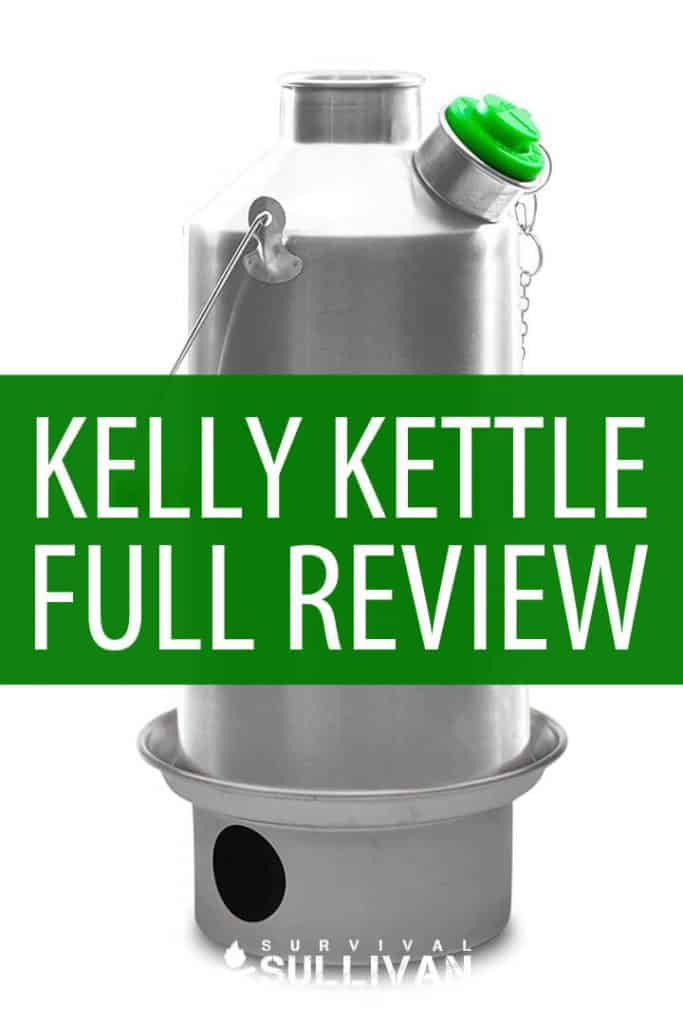A Kelly kettle is not just another brand of electric or gas kettle, it’s a unique camping kettle that requires just a bit of grass and a few twigs to deliver boiling water in just six minutes. For anyone who has tried boiling water over a fire is a pretty nifty time.
When you are prepping this is the kettle to have – I doubt that even in a city you will be unable to find a few dry leaves, a handful of grass and a couple of twigs to get your fire going.
You can use it on a balcony in the city – using indoors may make an apartment a bit smoky, but heck if you have to survive you have to survive, and it’s perfect for bug out situations.
| Pros | Cons |
|---|---|
| ✅ Both aluminum and stainless steel models boil water in under 6 minutes | ❌ Must not be left to boil dry or laser welds may open causing leakage |
| ✅ Aluminum model is light and will not rust | ❌ Stainless steel can pick up surface rust |
| ✅ Stainless steel model is sturdier than aluminum and is easier to clean | ❌ Aluminum chimney can melt if left to boil dry |
| ✅ Boils on easily available free fuel – grass, twigs, and leaves. | ❌ To regulate the heat you need to stop feeding the fire, unlike the convenience of turning down the flame on gas. |
Who Invented the Kelly Kettle?
This kettle has a really interesting history going all the way back to 1890 on the West Coast of Ireland when Patrick Kelly, the great-great-grandfather of the present directors of the company, brothers Patrick and Seamus Kelly, used the winter time on his farm on the shores of Loch Conn to find a way to make himself hot drinks on his boat when he was out fishing.
The Irish weather, when it’s not perfect can be perfectly beastly, and for a fisherman out in windy and wet weather having something that could heat water on the boat made life just that bit more bearable.
First Patrick started out with designing a kettle from tin but those weren’t too durable – then he tried copper, which worked well but was a bit expensive.
In Ireland during the 1890’s the country suffered a potato famine in 1845 when the crops failed and absentee English landowners were not sympathetic to the starving tenant farmers.
The economy collapsed and many people in Ireland lived in extreme poverty. From necessity comes invention and Patrick’s little kettle, which he eventually started making from aluminum, hit the sweet spot for fishermen in the area all those years ago, and they soon asked for him to make them kettles too.
How it Works
The kettle has a little double walled base pot in which you place some dry leaves, and grass as tinder to start the fire. Onto this base fits the kettle that you fill with water, but this kettle is unique in that it has a hollow core in the middle into which you can place larger twigs to keep the fire fed.
The heat of the fire spreads up the hollow core, acting as a chimney, and heating the water from the center as well as from the base, giving you a faster boiling time. With the fire basically enclosed it means the kettle can be used in windy weather and light rain.
For heavy rain you may want to use one of the recent additions to the Kelly Kettle range, which is a pot support to heat food over the kettle, and put a metal plate over that to keep your kettle dry.
Fuel is Everywhere
The great things about this kettle is you can find fuel for it virtually anywhere – even in the city you’ll find some dry leaves and a bit of grass to get it going.
It’s a breeze to find fuel when out camping in the wilds, and for people who are living out of cars it provides a convenient way to make hot drinks and heat food safely. It is best to feed the fire from the top of the chimney once you have it going, but you also have the option of feeding from the base.
Safely Lifting the Kettle off Its Base and Pouring
Using both hands lift the kettle using the wire and wood handle keeping the handle parallel to the ground – if you tilt it up to above the kettle you risk burning yourself on the heat still coming from the chimney.
Once it is clear of the fire then you tilt the handle upward to carry in the normal way. To pour use the chain attached to tilt and pour while still holding onto the wooden handle firmly.
If you need more water you just refill the kettle and return it to the base where the fire will still be going and add a few more twigs down the chimney to get the next kettle of water boiling.
Environmentally Friendly
There are no fossil fuels involved and when you are finished it’s easy to tip out the few ashes and bury them leaving no trace of fire at your campsite. It is also allowed on airlines should you intend travelling to out-of-the-way places.
What can I use the Kelly Kettle for?
To boil water for any hot drinks – tea, coffee, hot chocolate, to add to instant noodles, instant soups, or to make couscous, and for dehydrated meals. With the addition of the Hobo stove you can prepare sausages, eggs and whatever else you fancy that cooks fairly quickly.
Precautions when using the Kelly Kettle
Do not fill it halfway full and forget about it – it can boil dry and the heat risks overheating the inner chimney on the aluminum model and melting it. There are no recorded cases of the stainless steel chimney melting – but it stands to reason to fill the kettle.
The 2-year anti-leak warranty will not be valid if it boils dry, as there is a risk of the laser-welded joints opening. If you need to boil smaller amounts of water then buy the 0.6-liter Trekker. The Scout model has a capacity of 1.2 liter – suitable for a small family and it also comes in a 1.6-liter size.
Some people want to know if they can use it on a gas or electric hob. Why would one want to do this? Use an ordinary kettle, as the Kelly Kettle is not designed for this and you risk damaging it.
Cleaning the Kelly Kettle
Use the correct aluminum or stainless steel cleaner for your model otherwise you risk corrosion. The inner chimney doesn’t really need cleaning – the soot from hardwood just tends to flake off, and anyway the black sooty covering on the chimney absorbs heat better and just helps it boil faster, plus it makes you look more of a seasoned camper.
If you do use pine cones then you may have a sticky residue build up on the chimney but you can clean this with wire wool and and vinegar and baking soda mix – it may take a bit of elbow-grease though.
For cleaning scale from the aluminum model make a mix 1 part vinegar to 2 parts water and bring it to the boil in the kettle, allow to cool to room temperature then rinse and clean with hot water.
The stainless steel version will benefit from one cup of baking soda topped up with water, brought to the boil, allowed to cool, tipped out then rinsed out with warm water.
New Developments in the Kelly Kettle Range
As word spread about the speedy little kettle people started asking for kettles of their own. At this stage Kelly kettles were only made in aluminum and had a 1.6-liter capacity, equivalent to 3.38 US liquid pints.
The kettles were still made to order and it was only when the current directors Patrick and Seamus, the fourth generation of the Kelly family, took over that they brought the kettle to an international market. By this stage the Internet had helped spread the word.
Patrick and Seamus listened to their customers and when they asked for stainless steel they started producing their kettle in this material. Although a little heavier than the aluminum the stainless steel version is sturdy.
Some people prefer the lighter aluminum kettles for back packing though, and some users have mentioned that the aluminum version is better for coastal use and humid place as it doesn’t rust.
Disclosure: This post has links to 3rd party websites, so I may get a commission if you buy through those links. Survival Sullivan is a participant in the Amazon Services LLC Associates Program. As an Amazon Associate, I earn from qualifying purchases. See my full disclosure for more.
If you’re using it in the Midwest then the stainless steel version won’t have a rust problem. You can get the aluminum version here.
Latest Developments
In the past five years the company has launched some add-ons to their basic Kelly Kettle. The hobo stove is the potholder mentioned earlier, that fits over the kettle enabling you to cook or warm food while the kettle boils.
Note we said while it boils – do not try and use the kettle without water and heat food. It is a kettle and therefore meant to be used with water – the fact that you can heat food at the same time above the kettle is a bonus.
There are even stainless steel plates and a set of stainless steel mugs, and the kettle now comes with a whistle to let you know when the water has boiled. All the add-ons come in a neat carry pack.
Elevating Camp coffee to Irish coffee
Why not go fully Irish and add a tot of Irish whiskey – Tullamore Dew is a favorite – to your camping coffee? Joe Sheridan, chef and bartender at the Flying Boat Terminal in Foynes, Ireland, is credited with creating Irish coffee.
When the flying boat to New York had to turn back due to bad weather in 1943, Sheridan was tasked with providing warming food and drink for the passengers after their aborted journey. He put Irish whiskey into their coffee, topped it off with cream and the rest, as the saying goes, is history.

Traveler, photographer, writer. I’m eternally curious, in love with the natural world. How people can survive in harmony with nature has fueled my food safety and survival gardening practices.
At the age of 12, I found a newspaper advertisement for a 155-acre farm at a really good price and showed my parents one Sunday morning. They bought it and I happily started planting vegetables, peanuts, maize and keeping bees with the help of the local labor.
Once I married wherever we moved it was all about planting food, keeping chickens and ducks, permaculture and creating micro-climates. I learned how to build wooden cabins and outdoor furniture from pallets, and baked and cooked home-grown produce, developing recipes as I went along.

